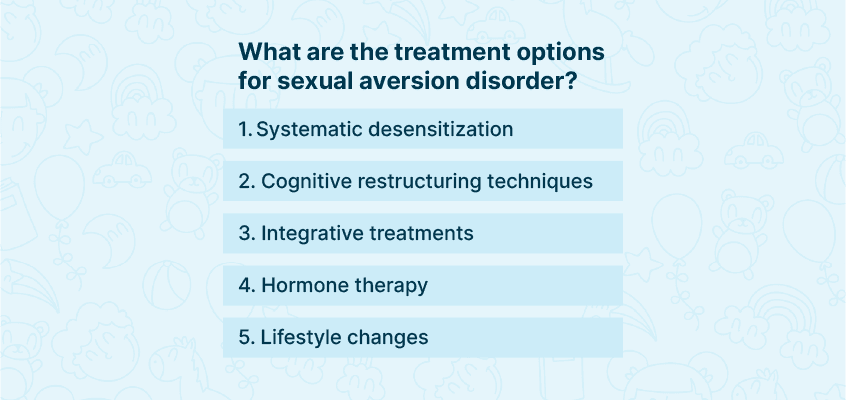Introduction
Sexual aversion disorders simply mean persistent avoidance of sex with the partner. Sexual aversion disorders steam from traumatic experiences that may interfere with a person’s life. The data suggest, 9% of patients who reported experiencing sexual avoidance met the criteria of panic disorders. The treatment plan of sexual aversion disorders and anxiety disorders has a lot more in common. However, psychologists use integrative treatment plans to manage symptoms of this disorder.
What is Sexual Aversion Disorder?
According to the Diagnostic and Statistical Manual of Mental Disorders (DSM), sexual aversion disorder (SAD) is the persistent avoidance or aversion of genital sexual contact with a sexual partner. Sexual aversion disorder belongs to the subcategory of hypoactive sexual desire disorder. Sexuality plays a crucial role in human life. Sexual aversion disorder causes severe distress in patients and causes further difficulty in a person’s marriage or relationships.
Types of sexual aversion disorder:
- Lifelong sexual aversion disorder: Patients with this type of SAD feel aversion even if they are in contact with their partner.
- Acquired Sexual aversion disorder: This type of aversion is specific to any relationship. The aversion does not impact other relationships.
Signs and Symptoms of Sexual Aversion Disorder:
Patients with sexual aversion disorder may experience psychological as well as psychosomatic symptoms. Here are some of them:
- Recurring aversion to sexual activity with a partner can cause a feeling of distress
- Extreme anxiety
- Fear and sense of threat
- Panic attacks trigger nausea, dizziness, faintness, palpitations, and breathing difficulties.
What causes Sexual Aversion Disorder?
Sexual aversion disorder is commonly seen among people who undergo traumatic events. It is majorly found among women who had past traumatic experiences that may involve rape, sexual assault, incest, and molestation. However, stress and reduced levels of sex hormones such as androgens and estrogens may contribute to the development of this order.
7 Shocking facts about Sexual Aversion Disorder:
Patients with sexual aversion disorder face many challenges due to threatening stimuli.
The symptoms of sexual aversion disorder may become severe if left untreated. This disorder also creates interpersonal difficulties. However, there are some factors related to this disorder. Here are some shocking facts about sexual aversion disorder:
- A link between anxiety and sexual aversion disorder: People who suffer from panic attacks, severe anxiety disorders are more likely to develop sexual aversion disorder (SAD). Sexual aversion disorder patients link sexual arousal to the sense of fear and threat.
- Panic attacks and Sexual aversion disorder: The study conducted by Kaplan with 373 patients pointed that 9% of patients who displayed signs of sexual aversion disorder were likely to suffer from panic attacks.
- Stomach-related issues in sexual aversion disorder patients: Patients with sexual aversion disorder feel severe disgust towards the notion of sex. Sexual aversion disorder may often make patients feel nauseated or fluttery. They often have stomach-related issues when they think about sex.
- Gender: Sexual aversion disorder is more common in women than men. In men, sexual aversion disorder is linked with performance anxiety.
- Personality traits: People with the tendency of panic attacks are more vulnerable to sexual aversion disorder, as they have personality traits such as separation anxiety, sensitivity towards rejection, and criticism from loved ones (partners in this case).
- Extreme aversion: These patients may also feel disgusted by the sight or smell of their partner’s genitalia, body fluids, and smell. Patients with this disorder may also refrain from indulging in activities like hugging, holding hands, kissing.
- Childhood and adolescent trauma: In some cases, childhood or adolescent experiences of sexual trauma or imposed feeling of shame for indulging in sex may lead to the development of sexual aversion disorder.
What are the treatment options for sexual aversion disorder?
Due to the similarity between sexual aversion disorder and anxiety disorders, the treatment options consist of many anxiety management techniques. In most cases, an integrative treatment plan is suggested to overcome multiple challenges of sexual aversion disorder:
- Systematic desensitization: The therapists use this technique to reduce the severity of anxiety. In systematic desensitization, therapists identify anxiety-causing stimuli and systematically expose patients to work out the response. This treatment is performed under the supervision of an experienced therapist. It also involves the use of various relaxation techniques as a part of desensitization. Once the therapist identifies all the distressing stimuli, desensitization techniques are used till the patient no longer feels threatened with those stimuli. The patient’s partner can also receive this treatment.
- Cognitive restructuring techniques: These kinds of techniques work on a patient’s dysfunctional beliefs and thoughts. The therapist helps identify stress and anxiety-causing thoughts and suggests strategies to manage them. Therapies like CBT, REBT can work in cognitive restructuring.
- Integrative treatments: Sexual aversion disorder needs an integrative treatment approach with the involvement of psychologists, sex therapists, doctors, and physical therapists. Counselling can help build empathy, anger management.
- Hormone therapy: If the patient’s aversion towards sex is due to hormonal decline, the doctor may suggest hormone therapy. Estrogen and testosterone play an important in sexual activity. The doctor may recommend hormone patches or vaginal creams that deliver estrogen.
- Lifestyle changes: Making certain lifestyle changes can support the treatment of sexual aversion disorder. It includes,
– Finding time for each other and prioritizing intimacy
– Following healthy diets
– Regular exercises and stress management can show positive mood changes,
better stamina, and increased libido.
– Practice mindfulness and relaxation techniques
Conclusion:
Living with sexual aversion disorder may impact a patient’s sexual relationships and overall wellbeing. Undetected or untreated sexual aversion disorder may cause significant harm to your relationships. With an integrative treatment approach and couples therapy, patients can improve their sex life. Seek professional guidance at United We Care Online mental health platform and get secure and convenient access to the support.




